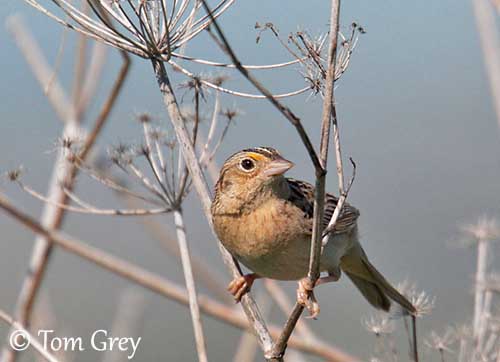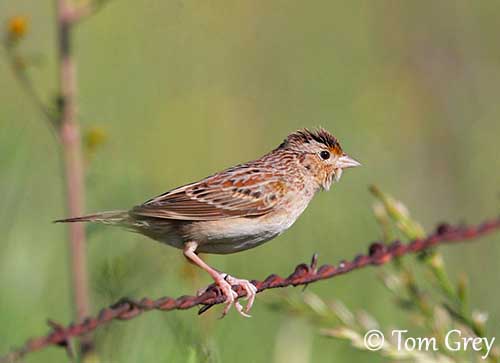
Fr: Bruant sauterelle
Ang: Grasshopper Sparrow
All: Heuschreckenammer
Esp: Chingolo Saltamontes - Gorrión chicharra (Puerto Rico)
Ita: Passero locustella
Nd: Sprinkhaangors
Sd: Gräshoppsparv
Photographers:
Tom Grey
Tom Grey's Bird Pictures
Simon Tan
PBase Bird galleries
Text by Nicole Bouglouan
Sources :
HANDBOOK OF THE BIRDS OF THE WORLD Vol 16 by Josep del Hoyo- Andrew Elliot-David Christie – Lynx Edicions – ISBN: 9788496553781
A GUIDE TO THE BIRDS OF MEXICO AND NORTHERN CENTRAL AMERICA by Steve N. G. Howell, Sophie Webb - Oxford University Press - ISBN: 0198540124
A GUIDE TO THE BIRDS OF COLOMBIA by Steven L. Hilty and William L. Brown - Princeton University Press – ISBN 069108372X
BirdLife International (BirdLife International)
Animal Diversity Web (University of Michigan Museum of Zoology)
All About Birds (Cornell Lab of Ornithology)
Bird Web (Seattle Audubon Society)
What Bird-The ultimate Bird Guide (Mitchell Waite)
Wikipedia, the free encyclopaedia
Grasshopper Sparrow
Ammodramus savannarum
Passeriformes Order – Passerellidae Family
INTRODUCTION:
The name of the Grasshopper Sparrow comes from its diet including of course grasshoppers, but also from its buzzy, insect-like song.
This species frequents open grasslands where the vegetation depends on the range. The nest is placed on the ground, well-hidden among the leaf litter and the short grasses. This species is migratory in the northern parts of the range.
DESCRIPTION OF THE BIRD:
Biometrics:
Length: 12 cm
Wingspan: 20-22 cm
Weight: 13-28 g, according to the subspecies.
The Grasshopper Sparrow adult has cryptic plumage on the upperparts with blackish, chestnut, grey and buff pattern. Wings and tail are brown with buff and pale brown edges. The outer rectrices are paler. We can see two pale buff wingbars on the upperwing. Rump and uppertail-coverts are mottled rufous.
On the underparts, throat, breast and flanks are buff but the throat is paler. The belly is mostly whitish.

On the head, the crown is blackish-brown with narrow, pale buff median stripe and buffish supercilium. Lores and ear-coverts are pale buffy-yellow. The head sides are pale buff whereas the nape is streaked greyish and blackish. The face is plain buff with pale eyering. The head is rather flat but occasionally, the bird may raise the crown feathers like a crest.
The fairly large, conical bill is greyish with dark culmen. The eyes are dark brown. Legs and feet are pinkish-flesh.
Male and female have similar plumages.
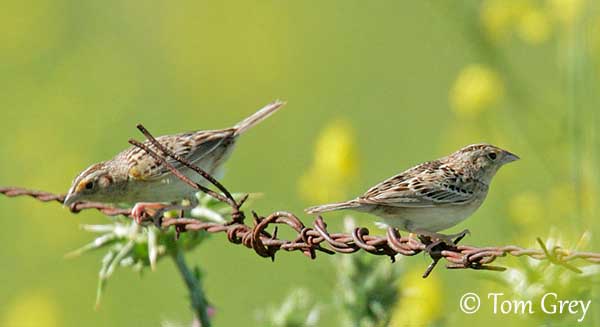
The juvenile has dark brown crown, nape and upperparts with pale buff to rusty brown feather edges. The underparts are whitish with brown-streaked breast. Rest of underparts are finely streaked and spotted brown. On the head, the face is brownish with paler eyering and supercilium.
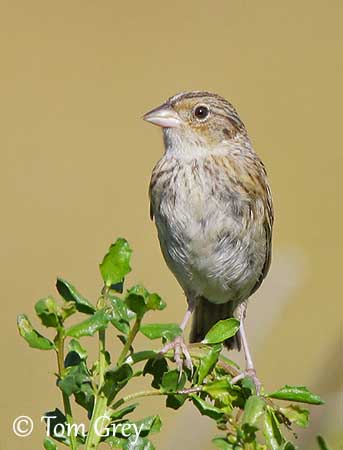
SUBSPECIES AND RANGE:
The Grasshopper Sparrow has twelve recognized subspecies throughout the wide range. Four are breeding in North America, four are resident in Mexico and four are resident in the Caribbean. The races differ mainly in size and bill size, and slightly in coloration.
The Grasshopper Sparrow breeds across Southern Canada, the USA, Mexico and Central America. There is a small endangered population in the Andes of Colombia, and probably in Ecuador too.
The northern populations migrate to south USA, Mexico, Central America and the Caribbean. This species is usually absent from the desert southwest.
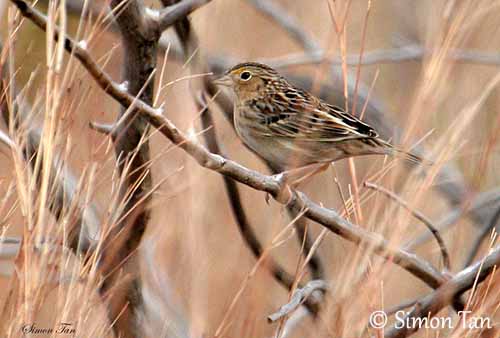
HABITAT:
The Grasshopper Sparrow usually frequents open grasslands where it forages on the bare ground. In the western parts of the range, it is mainly found in arid grasslands with shrub cover and more vegetation. In tall grass areas and wet grasslands of the eastern parts, it often frequents sparsely vegetated areas. It can be found up to 1500 metres of elevation in mountains, on limestone outcroppings.
CALLS AND SONGS: SOUNDS BY XENO-CANTO
The Grasshopper Sparrow’s call is a weak “tillic” or a soft, insect-like “tk” or “tik”. The song is a high-pitched, thin, insect-like buzz of 1-2 seconds which starts with one or more “ts, zzzziiir” notes audible at close range, giving a buzzy trill “pit-sip tzzzzzzzzzzz”.
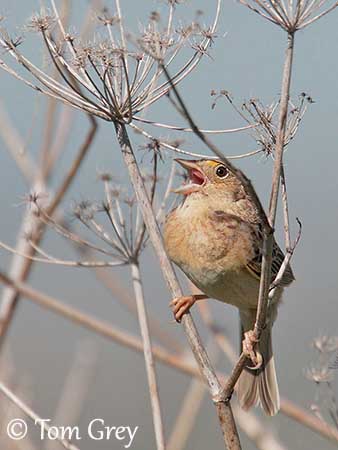
BEHAVIOUR IN THE WILD:
The Grasshopper Sparrow feeds mainly on insects and seeds according to the season. During summer, mostly insects are taken, including grasshoppers, beetles, caterpillars, ants, larval butterflies and moths, and some spiders, snails and earthworms. During winter, it feeds mainly on seeds from weeds and grasses, and also waste grain.
The Grasshopper Sparrow forages on or near the ground and in low vegetation. The grasshoppers are taken around the thorax and immobilized. The chicks are fed on insects, after removing the hard, indigestible parts.
The bird runs or walks on the ground, and occasionally hops. It spends much time foraging, but during the breeding season, the male sings and displays aggressively to defend the territory.
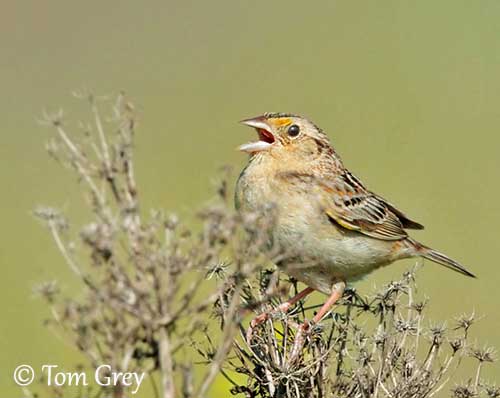
The Grasshopper Sparrow is seasonally monogamous, although some cases of polygyny have been recently reported. The male sings and performs a fluttering flight display in order to attract a female. The pair-bond is maintained throughout the breeding season by contact calls given by both sexes.
This species may have helpers, often juveniles from earlier broods. The helpers take part in some nesting duties and feed the chicks.
The Grasshopper Sparrow from the northern parts of the range is migratory, whereas the other populations are resident, with some local movements related to rains and grass heights.
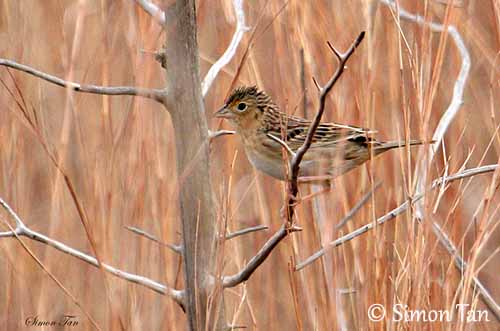
The flight is usually short and direct. However, during the breeding season, the flight is short and fluttery, with zig-zagging movements before to reach the vegetal cover. The male performs fluttering flight between its song perches, and rapid undulating flights.
REPRODUCTION OF THIS SPECIES:
The breeding season varies depending on the range. Two or more broods can be raised, but further south, up to four broods are reported. The Grasshopper Sparrow nests in grasslands.
The male establishes the territory, and once the pair is formed, the female builds the nest, a cup-shaped structure placed on the ground, well-hidden among the vegetation. There is a roof or dome of overhanging grasses and a side entrance. The nest is made with grasses and the interior is lined with softer materials. A new nest is built for each new brood.
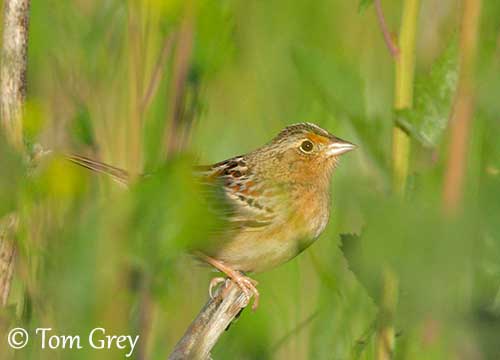
The female lays 4-5 creamy-white eggs with red-brown markings. She incubates during 11-13 days. The chicks are fed by both parents and by helpers if present. They leave the nest 8-9 days after hatching, by running instead of flying. They leave the area after fledging, and the post fledging care may last from 4 to 19 days. The juveniles usually form groups 3-4 weeks after hatching, while some of them remain with the adults as helpers.
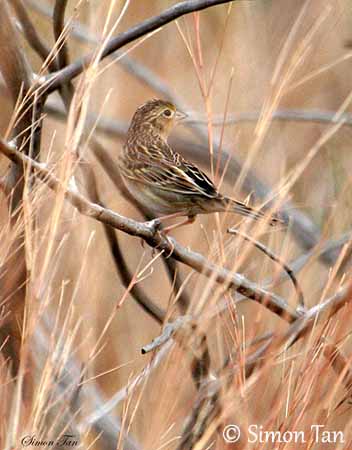
PROTECTION / THREATS / STATUS:
As a ground-nester species, the Grasshopper Sparrow is threatened by several predators such as snakes, skunks, racoons, weasels, ground squirrels, foxes, cats and pigs. The adults are preyed upon by hawks and the Loggerhead Shrike.
This species is usually common in suitable habitat, but many populations are decreasing due to habitat loss for agriculture expansion and urbanization.
However, the Grasshopper Sparrow is currently evaluated as Least Concern.
